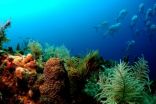(Press-News.org) Without fungi and microbes to break down dead trees and leaf litter in nature, the forest floor might look like a scene from TV's "Hoarders."
Massive-scale genome sequencing projects supported by the U.S. Department of Energy (DOE) and being carried out at the DOE Joint Genome Institute (JGI) highlight the importance of learning how the cellulose, hemicellulose and lignin that serve as a plant's infrastructure can be broken down by these forest organisms to extract needed nutrients. Among the fungi being studied are species that can selectively break down the cell wall components cellulose and lignin—the number one and two most abundant biopolymers on Earth.
In a study published online the week of March 19, 2012 in the Proceedings of the National Academy of Sciences, an international team of scientists presented a comparative genomic analysis of two white rot fungi whose genomes were generated and annotated at the DOE JGI under the Community Sequencing Program (CSP). Both the fungus Phanaerochaete chrysosporium (sequenced by DOE JGI in 2004), and its close relative Ceriporiopsis subvermispora are found all over the world and are of interest to bioenergy researchers because they possess enzymes that can break down plant biomass and could therefore be useful for accelerating biofuels production. The study revealed substantial differences among the sets of genes involved in lignocellulose degradation, providing further insight into the mechanics of how white rots do their dirty work.
"The fact that we have such a large group of people involved in this project is a clear demonstration that there's certainly interest in enzyme discovery," said study senior author and DOE JGI collaborator Dan Cullen of the U.S. Department of Agriculture Forest Service, Forest Products Laboratory (FPL). "In this particular case though, one would come away thinking more about the role of white rot fungi in the carbon cycle. Lignin is a recalcitrant compound in forest ecosystem biomass and very few fungi have the capability to degrade lignin. Even fewer fungi have the ability to selectively remove lignin at such an efficient rate. C. subvermispora is one exception in its ability to do just that."
Cullen and his colleagues compared the fungal genomes to learn more about the basis of C. subvermispora's ability to selectively break down lignin. Understanding this process of selective ligninolysis is of longstanding interest to the pulp and paper industry. According to the American Forest & Paper Association, approximately $175 billion worth of forest products such as pulp and paper are produced annually, and account for five percent of the nation's GDP.
Analyzing the diversity of wood-decaying fungi and cataloging enzymes involved in lignocellulose degradation is one of the goals of the DOE JGI Fungal Genomics Program led by Igor Grigoriev. "We are in the process of conducting functional comparative genomics of more than 20 such fungi sequenced or currently being sequenced at the DOE JGI," he said. "This should provide us a better understanding of the diverse and complex mechanisms of lignocellulose degradation in fungi, the influence of these mechanisms on carbon cycling in the forest ecosystem, and ultimately lead to improvements in biopulping."
Kent Kirk, a former FPL researcher who is considered a leading figure in the study of lignin degradation by fungi, provided perspective on how the current research could impact the pulp and paper industry. "This grew out of fundamental research by the University of Minnesota and the FPL where they applied the concept of 'biopulping'—the partial decay of wood by lignin-degrading fungi to decrease the energy required for mechanical pulping. Cerioporiopsis subvermispora quickly became the 'biopulper' of choice." Kirk described how wood chips treated with the fungus for two weeks required 30% less energy for pulping than untreated chips and how outdoor trials were repeatedly successful at the 50-ton scale. "The technology has not yet been commercially adopted, but as energy costs continue to rise, it should be increasingly attractive for implementation," Kirk said.
With detailed biochemical analyses conducted by study co-author Angel Martinez's team at the Spanish National Research Council (CSIC) in Madrid, Spain, the researchers found that the C. subvermispora genome had more manganese peroxidases and laccase—enzymes that may speed the degradation of lignin—than the P. chrysosporium genome. Martinez added that his group's work also revealed the presence of other lignin-degrading enzymes that had not previously been found in C. subvermispora cultures.
"Since Phanaerochaete doesn't have laccases, they're not absolutely necessary for lignin degradation," said Cullen, "though it could be that they're very important and play a role in Ceriporiopsis. The most persuasive part of the data are the expansion and expression of the manganese peroxidases, whose role in lignin degradation is more generally accepted."
Cullen added that the paper also suggests the cellulose-degrading portion of C. subvermispora's genome is "somewhat repressed" relative to P. chrysosporium, another angle of further study to understand the Ceriporiopsis genome's selectivity for lignin. "It could be both," he said, "There's not a simple clear final answer. To really make direct progress on understanding the mechanism of selective lignin degradation, will require development of more experimental tools, such as those for genetic analysis. That is what's next."
###The DOE JGI, which has sequenced more fungi than any other institution in the world, recently issued the 2013 call for Community Sequencing Program (CSP) Letters of Intent for large-scale sequence-based genomic science projects. This call targets topics of relevance to DOE missions in alternative fuels, global carbon cycling, and biogeochemistry. Up to 50% of capacity for the 2013 CSP will be allocated for projects that address areas of plant and plant-microbe interactions, microbial emission and capture of greenhouse gases, metagenomics, and exploit such DOE JGI capabilities as single-cell genomics and DNA synthesis. For more information, go to http://1.usa.gov/JGI-CSP13.
The U.S. Department of Energy Joint Genome Institute, supported by the DOE Office of Science, is committed to advancing genomics in support of DOE missions related to clean energy generation and environmental characterization and cleanup. DOE JGI, headquartered in Walnut Creek, Calif., provides integrated high-throughput sequencing and computational analysis that enable systems-based scientific approaches to these challenges. Follow @doe_jgi on Twitter.
DOE's Office of Science is the largest supporter of basic research in the physical sciences in the United States, and is working to address some of the most pressing challenges of our time. For more information, please visit science.energy.gov.
Pulp NonFiction: Fungal analysis reveals clues for targeted biomass deconstruction
2012-03-26
ELSE PRESS RELEASES FROM THIS DATE:
Mayo Clinic-TGen study role testosterone may play in triple negative breast cancer
2012-03-26
SCOTTSDALE, Ariz. -- Could blocking a testosterone receptor lead to a new way to treat an aggressive form of breast cancer? That's a question researchers at Mayo Clinic in Arizona and the Translational Genomics Research Institute (TGen) are exploring. Preliminary results of a Mayo Clinic - TGen collaborative study shows the testosterone receptor may be a potential target to attack in treating triple negative breast cancer (TNBC).
Lead researcher Barbara Pockaj, M.D., a surgical oncologist at Mayo Clinic in Arizona will present the results of the study at the 65th annual ...
Magnetic field researchers target 100-tesla goal
2012-03-26
LOS ALAMOS, New Mexico, March 22, 2012 -- Researchers at Los Alamos National Laboratory's biggest magnet facility today met the grand challenge of producing magnetic fields in excess of 100 tesla while conducting six different experiments. The hundred-tesla level is roughly equivalent to 2 million times Earth's magnetic field.
"This is our moon shot, we've worked toward this for a decade and a half," said Chuck Mielke, director of the Pulsed Field Facility at Los Alamos.
The team used the 100-tesla pulsed, multi-shot magnet, a combination of seven coils sets weighing ...
Diatom biosensor could shine light on future nanomaterials
2012-03-26
SEQUIM, Wash. – A glow coming from the glassy shell of microscopic marine algae called diatoms could someday help us detect chemicals and other substances in water samples. And the fact that this diatom can glow in response to an external substance could also help researchers develop a variety of new, diatom-inspired nanomaterials that could solve problems in sensing, catalysis and environmental remediation.
Fluorescence is the key characteristic of a new biosensor developed by researchers at the Department of Energy's Pacific Northwest National Laboratory. The biosensor, ...
Ancient civilizations reveal ways to manage fisheries for sustainability
2012-03-26
In the search for sustainability of the ocean's fisheries, solutions can be found in a surprising place: the ancient past.
In a study published on March 23 in the journal Fish and Fisheries, a team of marine scientists reconstructed fisheries yields over seven centuries of human habitation in Hawaii and the Florida Keys, the largest coral reef ecosystems in the United States, and evaluated the management strategies associated with periods of sustainability. The results surprised them.
"Before European contact, Native Hawaiians were catching fish at rates that far ...
Adner Colon Attend Exclusive Action Freedom Legacy Mastermind Event at Hasbrouck Heights, NJ
2012-03-26
Online Marketing Entrepreneur Adner Colon knew his life would change when he joined Carbon Copy Pro in February 2012 but not in the way he expected.
Online Marketing Entrepreneur Adner Colon knew his life would change when he joined Carbon Copy Pro in February 2012 but not in the way he expected.
On March 24th and 25th Adner Colon will be attending an exclusive Action Freedom Legacy (AFL) Legacy Mastermind event at Hasbrouck Heights. The trainers for the event are Aaron and Sophia Raskin and members of the Loyal 9 who are top producers in the online marketing industry.
Here's ...
Low serum adiponectin levels predict future risk for asthma in women
2012-03-26
Low serum adiponectin levels predict an increased future risk for developing asthma in middle-aged women, particularly among smokers, according to a new study.
"Adiposity is known to be related to asthma. Although a causal link between adiponectin (a protein produced by adipose tissue) and asthma has been demonstrated in mice, the evidence in humans has been conflicting," said lead author Akshay Sood, MD, MPH, associate professor in the Division of Pulmonary and Critical Care Medicine at the University of New Mexico Health Sciences Center School of Medicine.
"In an ...
Periodontal therapy reduces hospitalizations and medical care costs in diabetics
2012-03-26
Tampa, Fla., USA – Today, during the 41st Annual Meeting & Exhibition of the American Association for Dental Research (AADR), held in conjunction with the 36th Annual Meeting of the Canadian Association for Dental Research, an abstract titled "Periodontal Therapy Reduces Hospitalizations and Medical Care Costs in Diabetics" to determine if periodontal treatment was associated with the number of hospitalizations and cost of medical care among diabetics with periodontal disease.
A longitudinal study compared medical costs for diabetic subjects with periodontal disease ...
Study: Preoperative estrogen-blocking therapy may preempt need for mastectomy
2012-03-26
Orlando – March 23, 2012. Preoperative treatment with aromatase inhibitors increases the likelihood that postmenopausal women with estrogen receptor-positive breast cancer will be able to have breast-conserving surgery rather than a mastectomy, according to the results of a national clinical trial presented today at the Society of Surgical Oncology annual meeting in Orlando, Fla.
"We found that half of the postmenopausal women in the study who initially faced having a mastectomy were able to have breast-conserving surgery after being treated for four months with an aromatase ...
New epilepsy gene located in dogs
2012-03-26
A new epilepsy gene for idiopathic epilepsy in Belgian Shepherds has been found in the canine chromosome 37. The research of Professor Hannes Lohi and his group conducted at the University of Helsinki and the Folkhälsan Research Center opens new avenues for the understanding of the genetic background of the most common canine epilepsies. The research also has an impact on the understanding of common epilepsies in humans. The research is published in the scientific journal PLoS ONE on March 23, 2012.
Epilepsy affects about 1-5% of the human population at some stage of ...
Overweight and obese women at greater risk of breast cancer recurrence
2012-03-26
Vienna, Austria: Women who are overweight or obese when they are diagnosed with breast cancer are at higher risk of cancer recurrence or related death than are leaner women, according to a new study to be presented to the 8th European Breast Cancer Conference (EBCC-8) today (Friday). This finding held true even though the study mandated that chemotherapy dosage be adjusted for body weight, and adds further to the evidence that lifestyle factors can influence cancer prognosis, a researcher will tell the conference.
Dr. Jennifer Ligibel, a medical oncologist at the Dana-Farber ...


